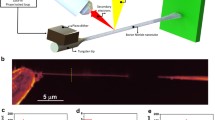Abstract
Insects constitute the most diverse and populated subclass of animals, with two million species identified. They also display a vast diversity of morphological and functional adaptations that allow them to thrive in various environments, which enables them to fly, swim, or walk nearly anywhere. Insects can be regarded as highly efficient and robust bio-machines, a precious source of material and information for bioinspired miniature technological devices. Yet, to date, little study of the functionality of insects has been undertaken with modern nanotechnology tools. Atomic force microscopy (AFM) is a technique generally used to study surface properties of materials at the nanoscale. Recently it has been shown that the AFM method can be extended to study complex living organisms, cells, and even entire animals, such as insects. AFM has demonstrated the feasibility of recording surface oscillations with sub-Angstrom spatial and sub-millisecond temporal resolutions while positioning the AFM probe at different parts of an insect with nanometer precision. In effect, it enables the AFM to function as a nanostethoscope. This article describes how such a nanostethoscope can be used to study the material properties, physiological reactions, and sensing mechanisms of insects.




Similar content being viewed by others
References
M.W. Westneat, O. Betz, R.W. Blob, K. Fezzaa, W.J. Cooper, W.-K. Lee, Science 299, 558 (2003).
S.K. Hetz, T.J. Bradley, Nature 433, 516 (2005).
L.J. Cator, B.J. Arthur, L.C. Harrington, R.R. Hoy, Science 323, 1077 (2009).
J.F. Windmill, J. Sueur, D. Robert, J. Exp. Biol. 212, 4079 (2009).
J.C. Jackson, J.F. Windmill, V.G. Pook, D. Robert, Proc. Natl. Acad. Sci. U.S.A. 106, 10177 (2009).
S. Iyer, R.M. Gaikwad, V. Subba-Rao, C.D. Woodworth, I. Sokolov, Nat. Nanotechnol. 4, 389 (2009).
M. Radmacher, M. Fritz, H.G. Hansma, P.K. Hansma, Science 265, 1577 (1994).
J. Domke, W.J. Parak, M. George, H.E. Gaub, M. Radmacher, Eur. Biophys. J. Biophys. Lett. 28, 179 (1999).
B. Szabo, D. Selmeczi, Z. Kornyei, E. Madarasz, N. Rozlosnik, Phys. Rev. E: Stat. Nonlinear Soft Matter Phys. 65, 041910 (2002).
G.N. Maksym, B. Fabry, J.P. Butler, D. Navajas, D.J. Tschumperlin, J.D. Laporte, J.J. Fredberg, J. Appl. Physiol. 89, 1619 (2000).
A.E. Pelling, S. Sehati, E.B. Gralla, J.S. Valentine, J.K. Gimzewski, Science 305, 1147 (2004).
M. Radmacher, M. Fritz, H.G. Hansma, P.K. Hansma, Science 265, 1577 (1994).
M.E. Dokukin, N.V. Guz, I. Sokolov, J. Insect Physiol. 57, 260 (2011).
N.V. Guz, M.E. Dokukin, I. Sokolov, PLoS One 5, e12834 (2010).
M.E. Dokukin, N.V. Guz, S. Vasilyev, I. Sokolov, Appl. Phys. Lett. 96, 043701 (2010).
K.M. Maredia, S.H. Gage, D.A. Landis, T.M. Wirth, Biol. Control 2, 253 (1992).
A.D. Briscoe, L. Chittka, Annu. Rev. Entomol. 46, 471 (2001).
M. Mishra, V.B. Meyer-Rochow, Invertebrate Biol. 125, 265 (2006).
B.N. Burkett, H.A. Schneiderman, Biol. Bull. 147, 274 (1974).
A.E. Pelling, P.R. Wilkinson, R. Stringer, J.K. Gimzewski, J. R. Soc. Interface 6, 29 (2009).
Acknowledgments
The author is thankful to Professor Daniel Robert for careful reading of the manuscript and suggesting numerous improvements.
Author information
Authors and Affiliations
Corresponding author
Rights and permissions
About this article
Cite this article
Sokolov, I. Toward the nanoscale study of insect physiology using an atomic force microscopy-based nanostethoscope. MRS Bulletin 37, 522–527 (2012). https://doi.org/10.1557/mrs.2012.91
Published:
Issue Date:
DOI: https://doi.org/10.1557/mrs.2012.91




